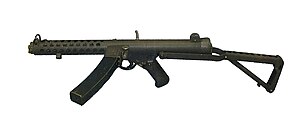Sterling submachine gun
| Sterling submachine gun | |
|---|---|

|
|
| general information | |
| Civil name: | Sterling MPi |
| Military designation: | SMG L2A1 (GB), C1 (Canada) |
| Country of operation: | UK , Canada , India (among others) |
| Developer / Manufacturer: | Sterling Armaments Company, Dagenham Royal Ordnance Factory, Fazakerley |
| Manufacturer country: | Great Britain |
| Production time: | 1953 to 1988 |
| Weapon Category: | Submachine gun |
| Furnishing | |
| Overall length: | 690 mm |
| Barrel length : | 198 mm |
| Technical specifications | |
| Caliber : | 9 mm parabellum |
| Possible magazine fillings : | 10, 15 or 34 cartridges |
| Ammunition supply : | Curve magazine |
| Cadence : | 550 rounds / min |
| Number of trains : | 6th |
| Twist : | right |
| Closure : | Mass closure |
| Charging principle: | Recoil loader |
| Lists on the subject | |
The Sterling submachine gun is a British infantry weapon. She was in service with the British Army and the armies of many Commonwealth countries .
History and technology
The development of the submachine gun began as early as the Second World War. Its designer was George William Patchett. However, it got its name after its manufacturing company, the Sterling Armaments Company . The first prototypes could not prevail against the Sten-MPi . It was not until 1953 that the Sterling was incorporated into the armed forces' equipment as the L2A1 .
As with the Sten, the magazine slot is typically British on the left. On the one hand, this should relieve the magazine springs somewhat, but above all offer advantages when firing while lying down or from under cover. In the beginning, bar magazines were used that were compatible with those of the Sten. For reasons of reliable ammunition supply, slightly curved curved magazines were later used. For the same reason, the feeder was replaced by two movably mounted rollers that are supported against the inside of the magazine, which generates far less friction than the feeders made of stamped sheet metal parts that were common at the time. The housing has been perforated for the tensioning lever so that the closing spring is also open. Sharp-edged grooves were therefore worked around the ground seal, which can absorb the ingress of dust and largely prevent malfunctions due to contamination.
A performance-enhanced pistol cartridge based on the 9 mm Parabellum was specially manufactured for the Sterling . However, it is only approved for submachine guns as it would place excessive demands on handguns.
commitment
The Sterling-MP proved to be extremely reliable and robust. It was used by the British Army for four decades and was only replaced by the SA80 assault rifle in the 1990s . However, some special versions are still in reserve today. A total of more than 400,000 copies were built, including under license in India and Canada. Great Britain exported the weapon to more than 70 countries, with it still in use mainly in Asia.
variants
| country | model | Weight (kg) | Length (mm) | Barrel length (mm) |
|---|---|---|---|---|
| United Kingdom | ||||
| L2A1 / Mk.2 | ||||
| L2A2 / Mk.3 | ||||
| L2A3 / Mk.4 | most commonly built standard version | 2.7 | 690 | 198 |
| L34A1 / Mk.5 | silenced version | 3.8 | 660 | 198 |
| Mk.6 | Police model | |||
| Mk.7 A3 | Paratrooper model, ultra short | 2.2 | 355 | 89 |
| Mk.7 A8 | Paratrooper model, short version | 2.3 | 470 | 198 |
| Canada | ||||
| C1 submachine gun | License model L2A1 | |||
| India | ||||
| SAF Carbine 1A | License model L2A1 | |||
| SAF Carbine 2A1 | Muffler model | |||
Others
The Sterling L2A1 / Mk.2 formed the basis for the "E-11 Blaster Rifle" used by the Imperial Stormtroopers in the 1977 film " Star Wars " by George Lukas . Instead of the magazine, an "energy cell" was inserted and a few additional plastic boxes and cable connections were attached
Web links
- Sterling SMG, operating manual (English; PDF file; 7.70 MB)
Individual evidence
- ↑ E-11 Blaster Rifle. Retrieved January 9, 2018 .
